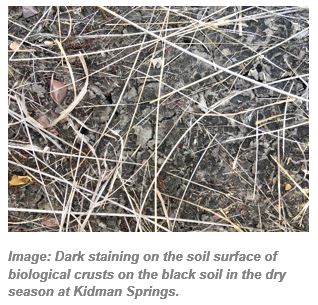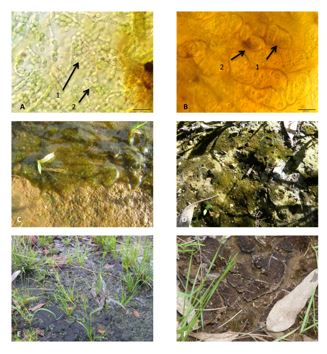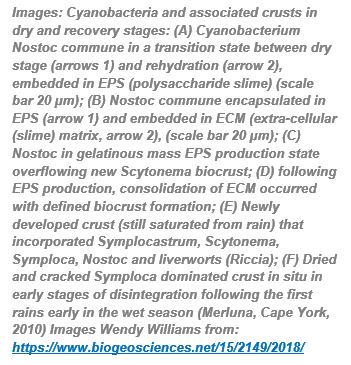New Biocrust project - Boosting natural regeneration of the nitrogen capital in grazing lands
The University of Queensland (UQ) has been funded by MLA to research the impacts of fire and grazing on the function of biocrusts. The UQ researchers are collaborating with the NT Department of Primary Industry and Resources (DPIR) at the Kidman Springs fire experiment and with the Qld Department of Agriculture and Fisheries at the Wambiana grazing trial in north Queensland.
What are biocrusts?
Biocrusts are the ‘living skin’ on the surface of the soil. They are composed of lots of different tiny organisms including cyanobacteria, fungi, green algae, bacteria, lichens, liverworts and mosses. They grow when it’s wet and become inactive when it’s dry, just like plants.
Why do we care about biocrusts?
They stabilise the soil surface - the filaments of the different organisms bind together the soil surface and prevent erosion from wind and water.
They photosynthesize and fix carbon – the algae and cyanobacteria are green and photosynthesize just like plants. The carbon is incorporated into the soil and enhances soil carbon.
They fix nitrogen! – most cyanobacteria fix nitrogen out of the air just like legumes do! The nitrogen is in a form available to plants with excess stored in the outer slime (EPS). When it rains much of the stored plant-available nitrogen is washed from the EPS into the surrounding soil. Additionally, when biocrusts dry out and a proportion will break down (particularly during the early wet season rains) at which time the nutrient-rich biocrust is incorporated into the soil as organic matter. The amount of nitrogen biocrusts fix every year is similar to the amount of nitrogen fixed by native legumes in our grassy tropical savannas.
Soil fertility is a major limitation to pasture growth in tropical savannas, but it doesn’t pay to add fertilisers because the extensive scale is prohibitive. We are testing if we can manage grazing and fire to maximise the natural carbon and nitrogen inputs by biocrusts into soils and enhance soil fertility in tropical savannas.
Where are biocrusts?
They are in the top one centimetre of the soil, usually covering the ‘bare’ spaces between plants. Biocrusts are found all over the world from freezing Iceland to hot deserts and wet-dry savannas, but different regions have different dominant organisms in the biocrusts, depending on the rainfall and temperature. In tropical savannas biocrusts are dominated by cyanobacteria.
What do they look like?
In northern Australia they often appear as dark staining on the soil surface in the dry season (Figure 1). They can form dark green slimy films during the wet season, as seen in the images below.
But wait, aren’t soil crusts a bad thing?
There are two types of soil crusts. Living biocrusts are distinct from dead physical soil crusts that form on degraded soils. Physical soil crusts can inhibit water infiltration and plant growth. Living biocrusts enhance soil moisture and plant growth.
What effect does fire and grazing have on biocrusts?
Fire can enhance biocrusts by removing litter, trees and shrubs that would otherwise compete as ground cover, yet you need the right amount of fire, not too much, not too little. Biocrusts in Australia’s tropical savannas, like our native vegetation, are well adapted to fire because they evolved with fire. Preliminary sampling at our Kidman Springs Fire experiment found the highest soil plant-available nitrogen (fixed by biocrusts), was in four yearly late dry season burnt sites, more than unburnt or two yearly late burnt sites.
Grazing can also potentially open up interspaces for biocrusts by reducing plant cover. Nevertheless, the trampling by hooved animals is not something Australian ecosystems have evolved with, so our biocrusts are quite susceptible to heavy trampling. The effects of moderate vs. heavy grazing on biocrusts will be examined at the Wambiana grazing trial near Charters Towers.
If trampling is bad for biocrusts how can we manage grazing to benefit biocrusts?
Biocrusts grow during the wet season, just like plants. During the dry season they dehydrate and become dormant. The carbon and nitrogen they fix is broken down and recycled by other critters in the biocrust, and then becomes incorporated into the soil and available to plants. We suspect that spelling over the wet season and grazing during the dry season will benefit not only palatable plants, but also biocrusts, allowing them to maximise their growth and nitrogen fixation. As pruning a shrub or tree in a garden encourages growth, moderate disturbance of biocrusts can promote growth. It is also possible that some intermediate level of grazing will enhance growth and productivity of biocrusts in the savanna.
Biocrusts facts
- Biocrusts cover more than 12 per cent of the Earths land surfaces and fix ~7 per cent terrestrial carbon and 45 per cent plant-available nitrogen.
- The growth of savanna grasses and forbs that don’t fix nitrogen is higher in the presence of biocrusts, probably because they benefit from the extra nitrogen fixed by the biocrusts.
- Cattle have been observed to lick biocrusts! (Anecdote from Bruce Alchin).
- There are viruses, bacteria and very small insects that make their living just off biocrusts. Samples of biocrusts from Kidman Springs examined under a microscope had ‘herds’ of tiny collembola (springtails) selectively grazing the cyanobacteria in the biocrusts, 'like cows in a paddock walking around from here to there searching for the legumes'. These are known to increase N-fixation by cyanobacteria!
- Biocrusts can be useful in land reclamation and rehabilitation. For example native seed germination and survival is higher when you coat them in cyanobacteria.
- Biocrusts reduce the germination of weeds.
- Biocrusts are often the dominant ground cover in deserts.
- Lichens and mosses dominate biocrusts in cold deserts (southern Australia), while cyanobacteria and liverworts dominate biocrusts in warmer environments (northern Australia).
For more information, please contact:
Robyn Cowley, Livestock Industry Development
Phone 0419 829 493
Email robyn.cowley@nt.gov.au
Give feedback about this page.
Share this page:
URL copied!


